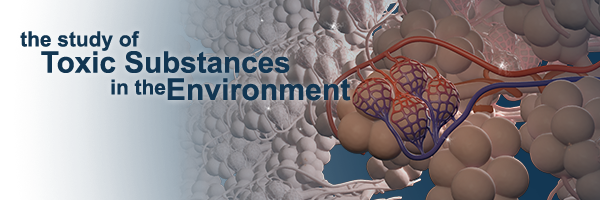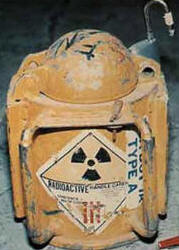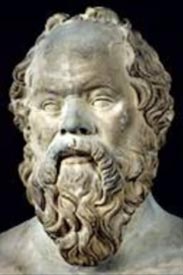

Socrates Award: Poison of the Year 2003
Radiological Dispersal Devices

Socrates Award by Student Vote
Overview
The Socrates Award 2003 Lecture will be given by Professor Greg Möller of the University of Idaho.
The Socrates Award recognizes the Poison/Toxin/Contaminant of the Year and is awarded by a tally of votes from the students taking the course Principles of Environmental Toxicology. The Socrates Award Lecture is an in-depth, critical analysis of the sources, pathways, receptors and controls for this agent of real or purported consequences on human health or the environment.
Socrates, the Greek philosopher, believed in the superiority of rational argument over writing and that all vice is the result of ignorance. He was convicted of crimes against the state and executed in 399 BC by drinking poison Hemlock. Read about Socrates.
Criteria for the Award
- The poison/toxin/contaminant must be a specific chemical or substance or closely related group of substances.
- The substance can have direct or indirect activity.
- The poison/toxin/contaminant must have been in the media arena in the past year.
- The poison/toxin/contaminant can present real, perceived or "hyped" risk to the general public or the environment.
- The issues surrounding the substance and its impact on human health and the environment would have inspired Socrates in vigorous debate!
Learing objectives
- Review the history and potential use of “radiological dispersal devices” (RDDs) - Dirty bombs
- Examine commercial radionuclide sources
- Examine the health consequences of radionuclide exposure
- Formulate a risk analysis for commercial source RDD use
- Examine the 1987 Goiania, Brazil incident
- Explore a hypothetical RDD incident and subsequent risks and protective actions
- Examine the conclusions concerning RDD health risk and psychosocial impacts
Resources
Keywords
- Roentgen (R) The roentgen is a unit used to measure a quantity called exposure. This can only be used to describe an amount of gamma and X-rays, and only in air. One roentgen is equal to depositing in dry air enough energy to cause 2.58E-4 coulombs per kg. It is a measure of the ionizations of the molecules in a mass of air. The main advantage of this unit is that it is easy to measure directly, but it is limited because it is only for deposition in air, and only for gamma and x rays.
- Rad (radiation absorbed dose) The rad is a unit used to measure a quantity called absorbed dose. This relates to the amount of energy actually absorbed in some material, and is used for any type of radiation and any material. One rad is defined as the absorption of 100 ergs per gram of material. The unit rad can be used for any type of radiation, but it does not't describe the biological effects of the different radiations.
- Rem (roentgen equivalent man) The rem is a unit used to derive a quantity called equivalent dose. This relates the absorbed dose in human tissue to the effective biological damage of the radiation. Not all radiation has the same biological effect, even for the same amount of absorbed dose. Equivalent dose is often expressed in terms of thousandths of a rem, or mrem. To determine equivalent dose (rem), you multiply absorbed dose (rad) by a quality factor (Q) that is unique to the type of incident radiation.
- Curie (Ci) The curie is a unit used to measure a radioactivity. One curie is that quantity of a radioactive material that will have 37,000,000,000 transformations in one second. Often radioactivity is expressed in smaller units like: thousandths (mCi), one millionths (uCi) or even billionths (nCi) of a curie. The relationship between becquerels and curies is: 3.7 x 1010 Bq in one curie.
Common Units - SI - International Standard
- Gray (Gy) The gray is a unit used to measure a quantity called absorbed dose. This relates to the amount of energy actually absorbed in some material, and is used for any type of radiation and any material. One gray is equal to one joule of energy deposited in one kg of a material. The unit gray can be used for any type of radiation, but it does not't describe the biological effects of the different radiations. Absorbed dose is often expressed in terms of hundredths of a gray, or centi-grays. One gray is equivalent to 100 rads.
- Sievert (Sv) The sievert is a unit used to derive a quantity called equivalent dose. This relates the absorbed dose in human tissue to the effective biological damage of the radiation. Not all radiation has the same biological effect, even for the same amount of absorbed dose. Equivalent dose is often expressed in terms of millionths of a sievert, or micro-sievert. To determine equivalent dose (Sv), you multiply absorbed dose (Gy) by a quality factor (Q) that is unique to the type of incident radiation. One sievert is equivalent to 100 rem.
- Becquerel (Bq) The Becquerel is a unit used to measure a radioactivity. One Becquerel is that quantity of a radioactive material that will have 1 transformations in one second. Often radioactivity is expressed in larger units like: thousands (kBq), one millions (MBq) or even billions (GBq) of a becquerels. As a result of having one Becquerel being equal to one transformation per second, there are 3.7 x 1010 Bq in one curie.
Discussion
- Is it possible to do a risk assessment of potential for terrorist activity?
- If psychosocial effects are the major result of an RDD event, how do public emergency preparedness personnel prepare for this?
- What would be your response if you were a downwind-er in an RDD event?
Suggested Reading
- Commercial Radioactive Sources: Surveying the Security Risks. Charles D. Ferguson, Tahseen Kazi, and Judith Perera January 2003. Center for Nonproliferation Studies (pdf 1MB)

ETox is licensed under a Creative Commons Attribution-NonCommercial-NoDerivatives 4.0 International License.
